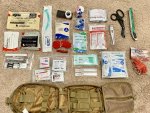Fish_monger
Lil-Rokslider
Im prepping for a 10 day back country trip with a buddy. At best, we’re probably 6 hours from medical attention so I thought it would be appropriate to bring a stocked first aid kit.
I picked up a “MyMedic” kit based on a recommendation from a friend. I’d love to take a first aid course but that’s off the table with COVID this year.
Most of the things in this kit are self explanatory. However, there are half a dozen items that I feel completely under qualified to handle. Mostly:
Chest seal
Quikclot
Trauma dressing
RAT tourniquet
Nasopharyngeal airway
Are these things an ametuer should be prepared to use? any resources recommended to learn proper application?

I picked up a “MyMedic” kit based on a recommendation from a friend. I’d love to take a first aid course but that’s off the table with COVID this year.
Most of the things in this kit are self explanatory. However, there are half a dozen items that I feel completely under qualified to handle. Mostly:
Chest seal
Quikclot
Trauma dressing
RAT tourniquet
Nasopharyngeal airway
Are these things an ametuer should be prepared to use? any resources recommended to learn proper application?


